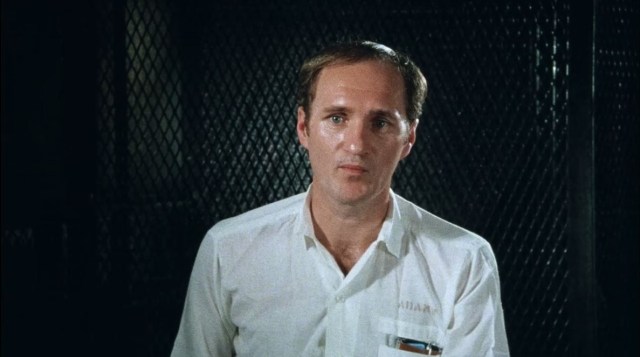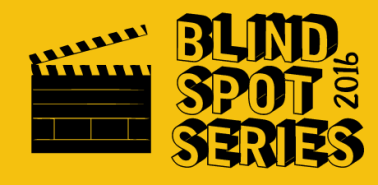
A film by Errol Morris, 1988.
Though Errol Morris has been increasingly prolific in film and television work since the early 2000s, his first few works were released more slowly. Prior to his 1988 documentary (or “nonfiction film” as some would have it) The Thin Blue Line, he had only made two other films. His 1978 debut, Gates of Heaven, is an eclectic examination of the owners and patrons of a pet cemetery, which manages to evoke deeply spiritual and human concerns despite—or because of—the sometimes vain and superficial subjects. Roger Ebert praised it in the highest terms, as “one of the greatest films ever made.” It was his “Great Movies” review which inspired me to take a look at Morris’s work for the first time.

An officer approaches his tragic destiny, setting in motion another tragedy.
Given a very different subject matter, Morris chose different narrative techniques to tell the story. He kept the ruminative editing style, lack of omniscient narration, and use of interviews with the subject facing directly at the camera, all of which he had developed in his earlier films. But Morris resisted cinema verité conventions of camera work, and particularly implications that objective truth could be found simply through the style of filming. Morris uses dramatic reconstructions of the various stories told by some of the subjects, along with carefully designed color and music choices to subtly enhance the viewer’s perception of the interviews. Not only the reenactments, but even the interviews were carefully staged and lit for particular effect. The fact that some resist the word “documentary,” particularly when applied to The Thin Blue Line, has much to do with these choices. As Charles Musser argues in his essay that accompanies the Criterion Blu-ray edition of the film, these film techniques “do not represent the incorporation of fictional modes into the documentary (and so blur the distinctions) but properly align the film with established legal conventions and the discourse of sobriety that is nonfiction.”

Randall Adams: “If there was ever a hell on earth, it’s Dallas County.”
So what is this film about? Briefly, it is a tale of a man wrongfully convicted and sentenced to death for the 1976 murder of a Dallas police officer. Over the course of the film, Morris explores the ways that the police, prosecution, and opportunistic false witnesses in effect conspired to miscarry justice against Randall Dale Adams. This is the sort of story that has become familiar through countless investigative reports on shows like 20/20, Dateline, or Primetime. In almost every case, the story is presented in a familiar way, with many of the same elements that Morris uses in The Thin Blue Line, such as face-to-camera interviews. But Morris sets himself apart from these boilerplate structured news stories especially with his elliptical editing and spiral-like narrative structure. He returns over and over to some of the details of the crime story, each time allowing us to consider it from a new or deeper angle, as new voices are introduced into the film. He eschews the TV-style voice over narrative, which simultaneously establishes a godlike authority to the narrator-reporter, and gives the audience a single, simple version of the story to follow. Instead, he lets the protagonists speak for themselves. There is no need for “gotcha” journalism or guerrilla ambushes of his interviewees. All of them seem very free with presenting their own version of the story, and Morris trusts his audience to come up with their own conclusions.

A subtle example of Morris’s telling details. The officer throws a Burger King cup, while an investigator remembered it as a Whataburger cup. This may seem insignificant, but testimony of such small details sent a man to death row.
It’s fairly inescapable that the wrong man was convicted (Adams was released in 1989 when his conviction was overturned on legal grounds), but The Thin Blue Line is not merely the story of injustice in the case of one innocent man. Morris’s style of presentation directs the attentive viewer to ask bigger questions about the implication of this case. If it could happen in this instance, could it happen again? Has it happened before in other cases? How many more? The conclusion I was led to was that the state tried and convicted Adams simply because they could. In the chilling words of one of Adams’s appellate attorneys, “Any prosecutor can convict a guilty man; it takes a great prosecutor to convict an innocent man.” Which is precisely what the state did.

David Harris: Polite, soft spoken, and unassuming. And a lifelong criminal, seemingly unmoved by the consequences of his actions.
From the start of the film, Morris presents the story in a ruminative, indirect style. Some of the basic facts of the case are revealed slowly, if repetitively. The viewer is given a chance to piece together the story in much the same way as a criminal investigator, putting together fragments of the story and seeing if they fit with the other pieces already assembled. The irony is that the audience-as-investigator will inevitably come to a very different conclusion from the one that the actual investigators decided upon. The depth of the collusion between the actual killer, the district attorney, and other parties is only gradually revealed.
Philip Glass, noted minimalist composer, provides a score that perfectly mirrors this approach. Glass incessantly turns over the same intervals in the strings, though at key moments provides just enough alteration in the pulsating pattern to create an emotional response, like an ominously descending bass line under a key testimony of an interviewee. For a sample of his scoring, see the following video:
The Thin Blue Line is a film masterpiece, a “monumental achievement in the documentary tradition,” in the words of Charles Musser. Roger Ebert called Errol Morris “one of America’s strangest and most brilliant documentary filmmakers.” This is a film which convinces without coercion, and looks deeply into the nature of truth and memory. Where the misshapen truth we call memory intersects with the demands and machinery of the criminal justice system, tragic consequences may result. In The Thin Blue Line, one man’s living example of such a tragedy becomes a canvas for Morris to open our minds to even greater and more fundamental questions about truth and justice. But on the other hand, can anything be greater or more fundamental than the life of a man?

David Harris has the last, fatalistic words in the film.
This post is part of the Blind Spot Series, hosted by The Matinee blog.


Nice review of this unique look at a terrible miscarriage of justice. I watched with equal parts fascination and disgust. Morris really does find ways to make the mundane memorable.
LikeLiked by 1 person
Indeed. Thanks for your comment, and for reading.
LikeLike